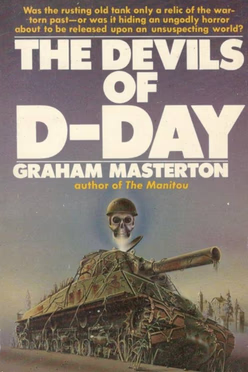The Devils of D-Day

My Dad is a voracious reader. As a child, I remember, in our basement, seeing washing-machine-sized boxes packed full of his old paperbacks. Some years after I’d graduated college, Dad went through those boxes.
He picked out his favorites, along with anything else he thought I might like, and gave them to me. In the years since, those several dozen books have followed me from house to house.
I’ve read maybe two or three of them.
Now, I’m making an effort to read more. In part because becoming a better writer means reading more. In larger part because my Dad curated these books. His opinion carries a lot of weight. He’s read more than anyone I’ve met.
Most of the books are science-fiction, my Dad’s favorite genre, but, knowing my penchant for horror, he included what little horror he’d accumulated.
That’s how I came to have a 1978 copy of Graham Masterton’s The Devils of D-Day. I remember shelving it after our latest move. The name Masterton seemed familiar. Didn’t he write The Manitou? Wasn’t that supposed to be good? I wasn’t sure and forgot about it within minutes.
Fast forward three years.
If I’d read its back cover blurb, Masterton’s book might still be gathering dust on that shelf. The plot synopsis suggests a haunted tank story and I’d just finished Stephen King’s Christine, a disappointing novel about a haunted car. The last thing I wanted was another haunted vehicle story. Fortunately, the blurb is misleading.
The story opens with our narrator, an American cartographer, discovering a mysterious tank in a remote French village. Abandoned by the Allies during World War II, it’s now overgrown with vines, but radiates an ominous aura. Closer inspection reveals the Allies sealed every possible opening, including welding a giant cross over the turret hatch.
Masterton doesn’t dawdle. Forty pages in, our narrator approaches the tank in the dead of night and discovers something trapped inside. Something persuasive. Masterton strikes a perfect balance of menace and otherworldliness.
The voice didn’t answer. It simply said: “You can help me, you know. You can open this prison. You can take me to join my brethren. You sound like a good man and true.”
Good stuff. Masterton doesn’t let up. Soon, the devil is free and our protagonist has struck a terrible bargain that sends him to England to uncover the tank’s secrets.
It’s not a book for the squeamish. Early on, a character vomits up thousands of squirming maggots. Later in the story, characters are disemboweled, sliced and skewered. Masterton uses these graphic scenes to establish the story’s authority. For modern audiences, softening the violence and gore would feel disingenuous.
Granted, the protagonists are nondescript and the plot has some holes, but Masterton compensates with arresting storytelling. Unlike Christine, which took a year’s worth of starts and stops, I devoured The Devils of D-Day in little more than a week. Finishing it left me eager to read more of Masterton’s work and excited about what other surprises might await me amongst my Dad’s books.
Reading History
- 2016Jan26TuePaperback (Pinnacle Books, 1978)
Read over 12 Days
- 15 Jan 20167%
- 17 Jan 201616%
- 18 Jan 201619%
- 20 Jan 201626%
- 23 Jan 201641%
- 24 Jan 201650%
- 25 Jan 201660%
- 26 Jan 2016Finished